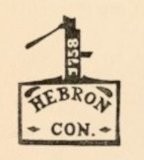
The Hebron Historical Society
Hebron, Connecticut
Enjoy Hebron - It's Here To Stay ™


Hebron Connecticut Bicentennial Booklet 1976
Until the year 2000, a large 2 story house built by the Owen family stood here. It was built in the 1750’s with a center chimney, wide double doors, and symmetrical windows larger in the principal front rooms and smaller elsewhere. The Owen family were farmers and merchants. By the mid 1700’s, Hebron had outgrown its settlement days of subsistence farms and was actively involved in the West Indian trade. Farmers provided much sought after food and lumber products to West Indian plantation owners who exported sugar, molasses and slaves. Distilling rum became a New England specialty, since New England had plenty of firewood and molasses could be transported cheaply in barrels to be turned into rum. Before the opening of the Midwest with the Erie Canal making wheat plentiful and whiskey cheap, rum was the drink of choice of New Englanders. Rum was also a major product in the triangle trade that brought African captives to the New World as slaves.
Think about it
The Sugar Islands of the West Indies were one of the richest areas of the world in the 1700’s because of the sugar they produced. Sugar is highly addictive and is in many products we eat today like candy. Sugar and sweet corn syrup are added to ketchup, pasta sauce, yoghurt, and salad dressings.
Would you be willing to give up consuming sugar, if it meant people everywhere on the globe could attain a higher standard of living?
Where to go next
From here walk toward the old burying ground on the sidewalk along Route 316
Meet Your Neighbors QR Tours funded by the Hebron Greater Together Community Fund in conjunction with the Hebron Historical Society